Osculum Study guides, Class notes & Summaries
Looking for the best study guides, study notes and summaries about Osculum? On this page you'll find 50 study documents about Osculum.
Page 2 out of 50 results
Sort by
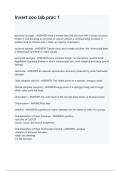
-
Invert zoo lab prac 1 questions and answers
- Exam (elaborations) • 6 pages • 2024
-
- $7.99
- + learn more
asconoid sponges - ANSWER-have a simple vase-like structure with a single osculum, limited in size because an increase in volume without a corresponding increase in surface area of choanocytes ( make up majority of sponges) syconoid sponge - ANSWER-Tubular body and a single osculum, the choanocyte layer is folded back and forth to make canals leuconoid sponges - ANSWER-more complex design, no real atrium, several small flagellated chambers instead in which choanocytes are, most adaptive an...
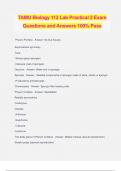
-
TAMU Biology 112 Lab Practical 2 Exam Questions and Answers 100% Pass
- Exam (elaborations) • 23 pages • 2024
- Available in package deal
-
- $12.49
- + learn more
TAMU Biology 112 Lab Practical 2 Exam Questions and Answers 100% Pass Phylum Porifera - Answer- No true tissues Asymmetrical symmetry Taxa: -Silicea (glass sponges) -Calcarea (rest of sponges) Osculum - Answer- Water exit in sponges Spicules - Answer- -Skeletal components of sponges made of silica, calcite or spongin -Produced by amoebocytes Choanocytes - Answer- Spong's filter-feeding cells Phylum Cnidaria - Answer- Diploblastic Radially symmetrical Cnidocytes Classes: -Anthozoa...
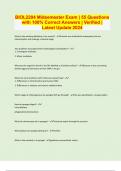
-
BIOL2204 Midsemester Exam | 55 Questions with 100% Correct Answers | Verified | Latest Update 2024
- Exam (elaborations) • 7 pages • 2023
-
- $10.49
- + learn more
What is the working definition of an animal? - Animals are multicellular eukaryotes that are heterotrophic and undergo a blastula stage Two problems associated with morphological classification? - 1. Convergent evolution 2. Minor mutations Why was the organism found in the 90s labelled as a bivalve mollusc? - Because it was consuming bivalve eggs and had traces of their DNA in its gut. What are some problems with molecular sequencing? - 1. Differences in mitochondrial and nuclear DNA ...
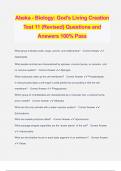
-
Abeka - Biology: God's Living Creation Test 11 (Revised) Questions and Answers 100% Pass
- Exam (elaborations) • 6 pages • 2024
-
- $11.49
- + learn more
Abeka - Biology: God's Living Creation Test 11 (Revised) Questions and Answers 100% Pass What group includes snails, slugs, conchs, and nudibrancks? - Correct Answer ️️ - Gastropods What sessile animals are characterized by spicules, incurrent pores, an osculum, and no nervous system? - Correct Answer ️️ -Sponges What molecules make up the cell membrane? - Correct Answer ️️ -Phospholipids In what process does a cell engulf a solid particle by surrounding it with the cell me...
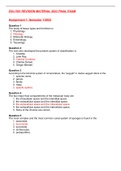
-
ZOL1501 REVISION MATERIAL 2023 FINAL EXAM
- Exam (elaborations) • 19 pages • 2023
-
- $15.99
- + learn more
ZOL1501 REVISION MATERIAL 2023 FINAL EXAM Assignment 1: Semester 1/2023 Question 1 The study of tissue types and functions is 1. Physiology. 2. Histology. 3. Molecular Biology. 4. Entomology. 5. Tissuology. Question 2 The man who developed the present system of classification is 1. Aristotle. 2. John Ray. 3. Carolus Linnaeus. 4. Charles Darwin. 5. Gregor Mendel. Question 3 According to the binomial system of nomenclature, the "aegypti" in Aedes aegypti refers t...
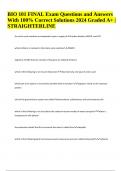
-
BIO 101 FINAL Exam Questions and Answers With 100% Correct Solutions 2024 Graded A+ STRAIGHTERLINE
- Exam (elaborations) • 21 pages • 2024
- Available in package deal
-
- $19.99
- + learn more
BIO 101 FINAL Exam Questions and Answers With 100% Correct Solutions 2024 Graded A+ STRAIGHTERLINE. which cofactor is involved in the Calvin cycle reactions? NADP+ segments of DNA that are not part of the gene are called introns which of the following is not true of ribosomes they bind only one type of amino acid which part of an operon is incorrectly matched with its function? regulator--binds to the repressor protein cells of the ground tissue system are called parenchyma, collenchyma, an...
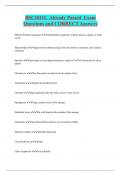
-
BSC1011L Already Passed Exam Questions and CORRECT Answers
- Exam (elaborations) • 15 pages • 2024
-
- $8.49
- + learn more
Phylum Porifera (sponges) multicellular organisms without tissues, organs, or body cavity Heterotroph organism that obtains energy from the foods it consumes; also called a consumer Spicules hard spear or star-shaped structures; made of CaCO3 (limestone) or silica (glass) Choanocyte line the gastrovascular cavity & capture food Amoebocyte digest & distribute food Osculum large opening at the top where excess water leaves Spongocoel large central cavity of the sponge
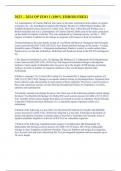
-
2023 – 2024 OP ZOO 1 (100% ERROR-FREE)
- Exam (elaborations) • 57 pages • 2023
-
- $14.49
- + learn more
1.A contemporary of Charles Darwin who came to the same conclusion in the matter of organic evolution was- (A) Jean Baptist Lamarck (B) Thomas Huxley (C) Alfred Russel Wallace (D) Franklin Benjamin correct answers (C) (SSC CGL 2014) Exp: Alfred Russell Wallace was a British naturalist and was a contemporary of Charles Darwin, Both came to the same conclusion on the matter of organic evolution. This was announced by Linnaean society, on July 1, 1958. Organic evolution is defined as the change in ...
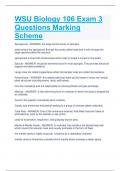
-
WSU Biology 106 Exam 3 Questions Marking Scheme
- Exam (elaborations) • 18 pages • 2023
- Available in package deal
-
- $13.99
- + learn more
WSU Biology 106 Exam 3 Questions Marking Scheme Spongocoel - ANSWER- the large central cavity of sponges. water enters the spongocoel through tiny pores called ostia and it exits through the large opening called the osculum. spongocoel is lined with choanocytes which help to create a current in the water. Spicule - ANSWER- structural elements found in most sponges. They provide structural support and deter predators. Large ones are called megascleres while microscopic ones are calle...
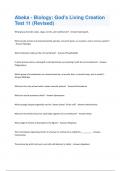
-
Abeka - Biology: God's Living Creation Test 11 (Revised) Questions and Answers 2024 Complete;100%
- Exam (elaborations) • 5 pages • 2024
- Available in package deal
-
- $7.99
- + learn more
What group includes snails, slugs, conchs, and nudibrancks? - Answer-Gastropods What sessile animals are characterized by spicules, incurrent pores, an osculum, and no nervous system? - Answer-Sponges What molecules make up the cell membrane? - Answer-Phospholipids In what process does a cell engulf a solid particle by surrounding it with the cell membrane? - AnswerPhagocytosis Which group of invertebrates are characterized by a muscular foot, a visceral hump, and a mantle? - Answer-Mollus...

How did he do that? By selling his study resources on Stuvia. Try it yourself! Discover all about earning on Stuvia


